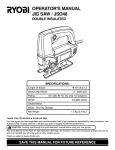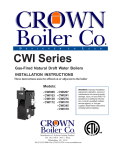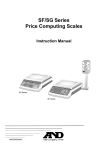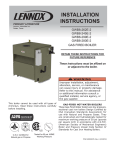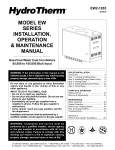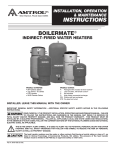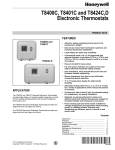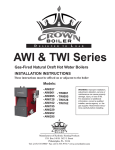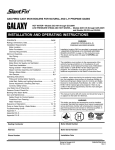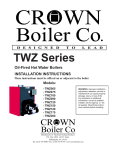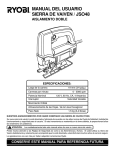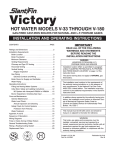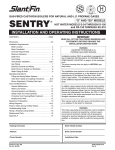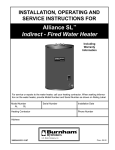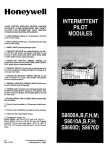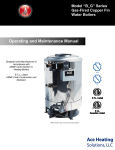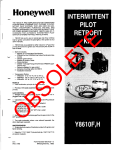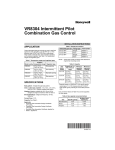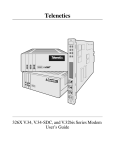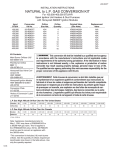Download Honeywell D896 User's Manual
Transcript
D896 Automatic Vent Damper PRODUCT DATA FEATURES • 4-wire plug receptacle. • Includes wiring harness on select models to fit plug receptacle onto S86/S8600/S8610/S8620 /L7148/L8148 or Penn Baso G60 or G66. • For use only on atmospheric type gas-fired furnaces and boilers equipped with draft hoods. • Applicable to direct spark ignition (DSI), intermittent pilot (IP), hot surface ignition (HSI), and standing pilot systems. • Ambient temperature range 32°F (0°C) to 150°F (65°C). • Requires dual automatic combination gas control valve or two separate single function main gas valves. • Interlock switch provides safe operation; burner fires only with damper in open position. GENERAL D896 Automatic Vent Dampers are used with atmospheric type, gas-fired equipment to reduce home heating losses by closing off the vent between heat cycles. • 24V operation for easy, low-cost wiring. • Visual indicator shows damper position. • 30-second nominal closing time for optimum energy savings. • Quiet motor and relay. • Wiring harnesses available separately to fit a variety of applications. Contents General ............................................................................... Features .............................................................................. Specifications ...................................................................... Ordering Information ........................................................... Application ........................................................................... Installation ........................................................................... Settings ............................................................................... Operation and Checkout ..................................................... Troubleshooting ................................................................... Instructions to the Homeowner ........................................... ANSI Standards .................................................................. ® U.S. Registered Trademark Copyright © 1997 Honeywell Inc. • All Rights Reserved 1 1 2 2 3 4 7 7 8 9 10 68-0186 D896 AUTOMATIC VENT DAMPER Application: For use only on Underwriters Laboratories Inc. listed and American Gas Association design certified atmospheric type, gas-fired furnaces and boilers equipped with a draft hood that has an outlet area no larger than the damper inlet area. Do not use with oil-fired furnace or boiler, power burner, or direct vent furnace or boiler. See Location and Mounting subsections in Installation section for additional application considerations. SPECIFICATIONS IMPORTANT The specifications given in this publication do not include normal manufacturing tolerances. Therefore, this unit might not exactly match the listed specifications. Also, this product is tested and calibrated under closely controlled conditions, and some minor differences in performance can be expected if those conditions are changed. Maximum Appliance Input Rating: TRADELINE® Models TRADELINE® models are selected and packaged to provide ease of stocking, ease of handling, and maximum replacement value. TRADELINE® model specifications are the same as those of standard models except as noted below. TRADELINE® Models Available: D896 Automatic Vent Damper with 4-wire plug receptacle. Features: • TRADELINE® pack with cross reference label. • 8 ft (2.4m), 4-wire cable with mating plug for D896 on one end and mating plug for 86/S8600/S8610/S8620 or Penn Baso G60 or G66 plug receptacle on the other end. Both ends equipped with an outlet box connector. Standard Models Models: D896 Automatic Aluminized Vent Dampers: available in 4 in. to 9 in. D896 Stainless Steel Vent Dampers: available in 10 in. to 12 in. Actuator assembly includes motor, relay, interlock switch, safe-start circuit, and 4-pin plug receptacle. See Fig. 5. Nominal Damper Outlet Diameter Maximum Appliance Input (in.) (mm) (Btuh) (W) 4 102 95,000 27,835 5 127 148,000 43,364 6 152 212,000 62,116 7 178 290,000 84,970 8 203 377,000 110,461 9 229 475,000 139,175 10 254 590,000 173,500 11 280 715,000 210,300 12 305 942,000 277,000 Electrical Ratings: Power Supply: 24 Vac, 60 Hz. Power: Motor: 3.0 VA maximum. Relay: 0.1 VA maximum. Contact Rating: Relay: 10.0A at 250 Vac. End Switch (Micro): 3.0A at 24 Vac. Do not use with 120V or millivoltage, self-generating systems. Damper Size: 4, 5, 6, 7, 8, 9, 10, 11 and 12 in. diameter (102, 127, 152, 178, 203, 229, 254, 279 and 305 mm diameter). ORDERING INFORMATION When purchasing replacement and modernization products from your TRADELINE® wholesaler or distributor, refer to the TRADELINE® Catalog or price sheets for complete ordering number. If you have additional questions, need further information, or would like to comment on our products or services, please write or phone: 1. Your local Home and Building Control Sales Office (check white pages of your phone directory). 2. Home and Building Control Customer Logistics Honeywell Inc., 1885 Douglas Drive North Minneapolis, Minnesota 55422-4386 In Canada—Honeywell Limited/Honeywell Limitée, 35 Dynamic Drive, Scarborough, Ontario M1V 4Z9. International Sales and Service Offices in all principal cities of the world. Manufacturing in Australia, Canada, Finland, France, Germany, Japan, Mexico, Netherlands, Spain, Taiwan, United Kingdom, U.S.A. 68-0186 2 D896 AUTOMATIC VENT DAMPER NOTE: A minimum of a 30 VA transformer must be used when D896 is installed with S86/S8600/S8610/ S8620. Approvals: American Gas Association Certified: Certificate No. U-66-2A1. Canadian Gas Association Design Certified: 1029AVD-9081. Electrical Connections: Four-wire plug receptacle. Replacement Parts: Damper Actuator is field replaceable without removing the damper assembly from the stack. 197516A Wiring Harness is a 4-wire cable, 8 feet (2.5 meters) long, with D896 mating plug on one end and mating plug for S86/S8600/S8610/S8620 or Penn Baso G60 or G66 on the other. An outlet box connector is on each end. Thermostat Anticipator Setting: 0.13A. Operating Times: Approximate Damper Opening Time: 30 seconds. Approximate Damper Closing Time: 30 seconds. Temperature Ratings: Minimum Ambient: 32°F (0°C). Maximum Ambient: 150°F (66°C). Maximum Furnace Stack: 575°F (302°C). Shipping: -20°F to +120°F (-29°C to +49°C). APPLICATION The D896 Automatic Vent Damper is a 24 Vac, motorized stack damper. The damper closes off the furnace or boiler stack during the heating off-cycle. Use the D896 only on Underwriters Laboratories Inc. listed and American Gas Association design certified atmospheric type, gas-fired furnaces and boilers. The furnaces or boilers must be equipped with a draft hood that has an outlet area no larger than the damper inlet area. Do not use with oil-fired furnace or boiler, power burner, or direct vent furnace or boiler. Mounting: See Fig. 2. Vertical Stack: Any orientation. Horizontal Stack: The damper actuator must be on the left or right side of the vent. IMPORTANT Do not mount the vent damper with the actuator above or below the vent. Dimensions: See Fig. 1. DIM. F DIM. E DIA A DIA C DIA B DIM. G 1 1 (32) 4 3 4 (70) 2 3 7 (98) 8 BODY SIZE (REF) DIA. A in. (mm) DIA. B in. (mm) 4 (102) 5 (127) 3 15/16 (100) 4 15/16 (125) 4 (102) 5 (127) 6 (152) 7 (178) 8 (203) 5 15/16 (151) 6 15/16 (176) 7 15/16 (202) 9 (229) 10 (254) 11 (279) 12 (305) DIM. H 4 7/8 DIA. STD. KNOCKOUT (3) (ONE, OPPOSITE SIDE) DIA. C in. (mm) 9 (116) 16 DIM. D in. (mm) DIM. E in. (mm) DIM. F in. (mm) 4 1/16 (103) 5 1/16 (129) 1 9/16 (40) 1 9/16 (40) 4 1/2 (114) 4 1/2 (114) 6 (152) 7 (178) 8 (203) 6 1/16 (154) 7 1/16 (179) 8 1/16 (205) 1 9/16 (40) 3 3/16 (81) 3 3/16 (81) 8 15/16 (224) 9 15/16 (252) 10 15/16 (278) 9 (229) 10 (254) 11 (279) 9 1/16 (230) 10 1/16 (256) 11 1/16 (281) 11 15/16 (303) 12 (305) 12 1/16 (306) DIM. D DIM. G in. (mm) DIM. H in. (mm) 6 (152) 6 (152) 6 3/4 (171) 7 1/4 (184) 8 7/8 (225) 9 7/8 (251) 4 1/2 (114) 7 1/2 (191) 7 1/2 (191) 6 (152) 9 (229) 9 (229) 7 3/4 (197) 8 1/4 (209) 8 3/4 (222) 10 7/8 (276) 11 7/8 (301) 12 7/8 (327) 3 3/16 (81) 5 3/16 (132) 5 3/16 (132) 7 1/2 (191) 11 1/2 (292) 11 1/2 (292) 9 (229) 13 (330) 13 (330) 9 1/4 (235) 9 3/4 (248) 10 1/4 (260) 13 7/8 (352) 14 7/8 (378) 15 7/8 (403) 5 3/16 (132) 11 1/2 (292) 13 (330) 10 3/4 (274) 16 7/8 (428) M11381 Fig. 1. Installation dimensions in in. (mm). 3 68-0186 D896 AUTOMATIC VENT DAMPER IMPORTANT 1. The atmospheric draft hood outlet area must be smaller or equal to the inlet area of the damper assembly. 2. If a second gas valve needs to be installed, refer to the gas valve manufacturer instructions for the procedure. 3. Using a dual automatic valve combination gas control or two separate gas valves is required with the D896. 4. Do not use with L8148 or L8124 with manual/ automatic switch because the switch can override the safety interlock in the system wiring and cause a hazardous condition. 5. Do not install on an appliance equipped with an automatic valve with a manual opener unless the manual opener is rendered inoperative or the automatic valve is replaced with an automatic valve without a manual opener. 6. On retrofit applications, installation identification label (provided) must be filled out by installer and applied to outside of cover. Location The D896 must be installed after the furnace or boiler draft hood. See Fig. 2. Make sure the D896 Motor Actuator is readily visible and accessible. The damper must be located where air can freely circulate around it. WARNING: DO NOT INSTALL THE VENT DAMPER WITHIN 6 IN. (152 mm) OF COMBUSTIBLE MATERIAL. NO D896 MOTOR ACTUATOR VENT PIPE CURVE 2 DRAFT HOOD 1 CHIMNEY 3 INSTALLATION When Installing this Product… 1. Read these instructions carefully. Failure to follow them could cause a hazardous condition. 2. Check the ratings given in the instructions and on the product to make sure the product is suitable for your application. 3. Installer must be a trained experienced service technician. The D896 must be installed in compliance with local codes or the Natural Gas Installation Code CAN/CGA-B149.1-B149.1-M91 and CSA C22.2 #3 Electrical Features of Fuel Burning Equipment, or the National Fuel Gas Code (ANSI Z223.1—NFPA 54) and the National Electrical Codes (ANSI C1—NFPA70). Use the ANSI Standard Z21.66-1994 included at the end of this specification during installation. FURNACE OR BOILER 1 INSTALL THE VENT DAMPER TO SERVICE ONLY THE SINGLE APPLIANCE FOR WHICH IT IS INTENDED. IF IMPROPERLY INSTALLED, A HAZARDOUS CONDITION, SUCH AS AN EXPLOSION OR CARBON MONOXIDE POISONING, COULD RESULT. 2 DO NOT INSTALL THE VENT DAMPER ON VENT PIPE CURVE. 3 DO NOT RUN WIRES NEAR HIGH TEMPERATURE SURFACES. M11370 USE STAND-OFF BRACKETS IF NECESSARY. Fig. 2. D896 location. Do not install the D896: — Where the stack temperature is higher than 575°F (284°C). — Where the ambient temperature is higher than 150°F (66°C). — In small or enclosed spaces where temperature can exceed 150° F (66°C). See WARNING following. — On the vent pipe curve. See Fig. 2. NOTE: In Canada, the damper is not certified for retrofit application. Certification for the suitability of the damper and appliance combination must be determined by the Canadian Gas Association. WARNING 4. Install only on an appliance connected to a factory built chimney or vent that complies with a recognized standard, or to a masonry or concrete chimney that is lined with a material acceptable to local code. 5. After installation is complete, check out product operation as provided in the Checkout section. See Exhibits A and B at the end of this specification. Severe illness or death possible. Prevent explosion or carbon monoxide poisoning. Overheating can cause premature device failure. Be sure the D896 is used to control only one appliance. Mounting The damper must be mounted as close as possible to the draft hood without modifying the draft hood. The D896 can be mounted vertically or horizontally. When vertically mounting the vent damper, the motor actuator can be in any position. See Fig. 3. CAUTION Can cause electrical shock or equipment damage. 1. Disconnect power supply. 2. Do not install within 6 in. (152 mm) of combustible materials. 3. Do not negate the action of any existing safety or operational control. 68-0186 WATER HEATER Horizontal mounting requires the actuator to be located within 45 degrees directly above or directly below the horizontal diameter of the stack pipe. See Fig. 2 and 3. 4 D896 AUTOMATIC VENT DAMPER HORIZONTAL VENT INSTALLATION D896 NO YES YES FROM FURNACE OR BOILER TO CHIMNEY FLOW VERTICAL VENT INSTALLATION NO INSTALL VENT DAMPER ONLY WITH ACTUATOR TO SIDES OF VENT. DO NOT MOUNT VENT DAMPER WITH ACTUATOR ABOVE OR BELOW THE VENT. TO CHIMNEY MOTOR ACTUATOR FLOW D896 INSTALL VENT DAMPER WITH ACTUATOR IN ANY POSITION. DAMPER BLADE PLUG DAMPER BLADE FROM FURNACE OR BOILER M11371 FOR DSI AND IP INSTALLATIONS ONLY – PLACE PLUG ON HOLE: HOLD DAMPER BLADE AND PUSH DOWN ON PLUG. Fig. 3. Installing D896 Vent Damper. M9675 Fig. 4. Installing damper blade plug. IMPORTANT Never mount the vent damper with the motor actuator above or below the vent. Wiring WARNING Do not install the damper blade plug if the vent damper is installed on a system with a continuous or standing pilot. The hole provides the minimum vent area required by code for safe operation. Severe illness or death possible. Prevent explosion or carbon monoxide poisoning. 1. Use dual automatic valve combination gas controls or two separate single function main gas valves with the D896. 2. Do not use the D896 with an L8148 or L8124 with a manual/automatic switch because the switch can override the safety interlocks in the system wiring and cause carbon monoxide buildup. Use the damper blade plug when the damper is installed on a system with either an intermittent pilot or direct ignition. The plug will increase system efficiency. See Fig. 4. To install the D896: 1. Push the female end of the vent damper over the section of vent pipe coming from the furnace or boiler, but after the draft hood. Push the section of the vent pipe coming from the chimney over the male end of the vent damper. 2. Secure the vent damper to the vent pipe with 1/2 in. (12 mm) sheet metal screws. Use only the holes provided. 3. Visually inspect the venting system for proper pitch. Pitch must comply with local codes or ANSI Z223.1— NFPA54. CAUTION 1. 2. 3. Remove the shorting plug on the S8600, S8610 or L8148E before attaching the wiring harness. Do not permit device wiring to contact high temperature surfaces. Label all wires prior to disconnecting when servicing controls. Wiring errors can cause explosion or carbon monoxide buildup. Important Do not operate the system with the D896 unplugged. Once the system has operated with the D896 plugged into the S8600, S8610 or L8148E, the control module will not operate. To install an additional gas valve: 1. Shut off the gas and electricity to the gas burner. (Use the manual shutoff valve in the supply line to the appliance.) 2. Locate a position in the supply line between the appliance automatic gas valve and the burner. 3. At the determined position, install an approved appropriately-sized, single-function automatic gas valve downstream from the existing automatic gas valve. Follow the valve manufacturer instructions for flow direction and position. 4. Restore the gas line supply and conduct a leak test on the gas piping and control system downstream from the appliance shutoff valve. D896 to L8148E, S8600F,H,M; S8610F,H Use the wiring harness included with the D896 to wire it according to the following instructions: 1. Connect the molex plug to the D896 Harness Cable Connector. See Fig. 5. 2. Use Fig. 6 and 7 to connect the other end of the harness to the furnace, boiler or control module. 3. Cycle system through at least two appliance operations. 5 68-0186 D896 AUTOMATIC VENT DAMPER Replacing D80B, D892 or Competitive Control with D896 D896 SERVICE SWITCH WARNING IGNITION GAS PWR LED NORM SERV Bodily harm and/or death possible. Prevent unsupervised gas flow. Improper wiring (device malfunction) of the D80B, D892, D896 or competitive devices can cause unsupervised gas flow. CALL FOR HEAT LED HARNESS CABLE CONNECTOR 1 RELAY 1K S3 SWITCH 1 A wiring harness is included with most D896 models. Use the harness to wire the D896 according to the furnace or boiler manufacturer wiring instructions, if available; otherwise, follow these instructions. If field wiring is required, see appliance manufacturer instructions or see Fig. 8 for a typical wiring example. See Table 1 for competitive wiring cross reference. Always cycle system through at least two appliance operations. Table 1. Wiring Cross Reference. USE STANDARD SCREWDRIVER TO MANUALLY OPEN AND CLOSE VENT DAMPER. PLACE SCREWDRIVER IN SLOTTED KNOB AND ROTATE COUNTERCLOCKWISE UNTIL M11373 BOTH LEDS TURN ON. Fig. 5. D896 with cover off. Honeywell D892/D896 Wires Honeywell D80B Wires Johnson Q35 Wires EFFIKAL RVG Wires Yellow Orange Green 1 Orange Blue and Red White 2 Blue Black Red 3 Black Yellow Black 4 24 Vac THERMOSTAT D896 L8148E1166/L7148 LED 2 4 4 4 NORMAL T W TV 1K R1, R2, R3 250 OHMS 2 K1 MOTOR WIRING HARNESS Z 6 2 S4 5 2 K1 C 1 N.O. 3 LED 1 FUSE S3 S1 N.C. 3 N.C. C N.O. N.C. N.O. SERVICE 5 S2 C 1 3 6-PRONG FEMALE MOLEX RECEPTACLE IN L8148E AND 5-PRONG MALE MOLEX PLUG ON CABLE POLARIZED 4-PRONG MALE MOLEX PLUG AND 4-PRONG FEMALE MATING PLUG ON CABLE SWITCHES AS SHOWN: S1,S2,S3 DAMPER OPEN DAMPER CLOSED C1 C2 L1 L2 1K1 B1 B2 CIRCULATOR L1 L2 (HOT) 1 POWER SUPPLY. PROVIDE DISCONNECT MEANS AND OVERLOAD PROTECTION AS REQUIRED. 1 2 AFTER D896 VENT DAMPER IS PLUGGED TO L8148E1166, FUSE BLOWS WHEN THERMOSTAT FIRST CLOSES. AFTER FUSE BLOWS, L8148E1166 OPERATES ONLY WHEN VENT DAMPER IS CONNECTED. 24V GND 24V 3 LED 1 LIGHTS WHEN DAMPER IS OPEN. 4 LED 2 LIGHTS WITH CALL FOR HEAT. 5 SERVICE SWITCH. THE NORMAL SWITCH SETTING IS NORM. IF THE SWITCH IS MOVED TO THE SERV POSITION, THE DAMPER REMAINS OPEN. 6 NO W,Z TERMINALS ON L7148. M11382 Fig. 6. Wiring diagram for D896 connection to L8148E1166 /L7148 using wiring harness with two Molex plugs. 68-0186 6 D896 AUTOMATIC VENT DAMPER S8600F, H, M; S8610F,H 1 GND MV MV/PV PV (BURNER) 2 24V GND 24V TH-W VENT DAMPER PLUG SENSE SPARK WIRING HARNESS 1 POWER SUPPLY. PROVIDE DISCONNECT MEANS AND OVERLOAD PROTECTION AS REQUIRED. 2 REMOVE PLUG ONLY IF USING VENT DAMPER. FUSE BLOWS ON STARTUP WHEN PLUG IS REMOVED; THEN MODULE OPERATES ONLY WHEN VENT DAMPER IS CONNECTED. D896 VENT DAMPER M11375 Fig. 7. Wiring diagram for D896 connection to S8600/S8610 using wiring harness with two Molex plugs. 1. When replacing a D80B or D892 with a D896, use the included wire nuts to connect the D80B or D892 cable to the D896 cable. See Fig. 9. a. Remove the black wire from the D80B (or D892) terminal 1. b. Use a wire nut to connect the D80B (or D892) black wire to the D896 blue wire. c. Remove the orange wire from the D80B (or D892) terminal 2. d. Wire nut the D80B (or D892) orange wire to the D896 yellow wire. e. Remove the red wire from the D80B (or D892) terminal 3 and the blue wire from the D80B (or D892) terminal 5. f. Wire nut the D80B (or D892) red and blue wires to the D896 orange wire. g. Remove the yellow wire from the D80B (or D892) terminal 4. h. Wire nut the D80B (or D892) yellow wire to the D896 black wire. 2. Cycle the system through at least two appliance operations. furnace or boiler burner lights. When the heating cycle ends, both LEDs turn off, the burner turns off and the damper automatically closes. Heating system efficiency is increased because the closed damper reduces the loss of residual appliance heat and heated room air through the draft diverter. D896 2 BLACK 1 ORANGE 3 BLUE YELLOW 4 LIMIT CONTROLLER 2 WIRING HARNESS THERMOSTAT 3 LIMIT CONTROLLER 1 L1 (HOT) L2 TRANSFORMER DUAL AUTOMATIC VALVE COMBINATION TH TH GAS CONTROL 1 Snap-Tite™ Connector Release To release the D896 cable from the knockout hole when secured with a Snap-Tite™ Box Connector (Fig.10), slip a screwdriver under the tab and twist. 2 1 POWER SUPPLY. PROVIDE DISCONNECT MEANS AND OVERLOAD PROTECTION AS REQUIRED. 2 CONNECT COLORS OF WIRING HARNESS AS SHOWN. M11372 3 ALTERNATE LIMIT CONTROLLER HOOKUP. SETTINGS Fig. 8. Wiring diagram for D896 connection to continuous pilot system using wiring harness with one Molex plug. The service switch operates in both normal (NORM ) or service (SERV) modes. See Fig. 5. NORM—D896 opens on a call for heat and closes at the end of the heating cycle. SERV—D896 remains open at the end of a call for heat. The switch must be in the SERVICE position before manually opening the damper. D80B CABLE ORANGE YELLOW BLACK YELLOW ORANGE OPERATION AND CHECKOUT RED D80B CONNECTOR Operation On a call for heat, the CALL FOR HEAT LED on the actuator lights and the damper begins to open. When the damper is fully open, the IGNITION GAS PWR LED lights and the D892/D896 CABLE BLUE BLACK BLUE M11383 Fig. 9. Connecting D80B, D892 Cable to D896 Cable. 7 68-0186 D896 AUTOMATIC VENT DAMPER 6. Cycle the heating system at least three times using the thermostat or controller to assure the system is operating safely. Cooling CAUTION Damage to air conditioner condenser possible. Do not operate cooling if outdoor temperature is below 50°F (10°C). 1. Set the thermostat or controller to COOL. Move the setpoint to 10°F (6°C) below the room temperature. 2. Make sure the cooling system operates. 3. Check that the D896 is in the closed position. See Fig. 11. 4. Return the thermostat or controller to the desired settings. NOTE TO INSTALLER: Explain to the homeowner that a yearly inspection by a trained, experienced service technician is necessary for safe, efficient operation of the vent damper and heating system. The homeowner should check for deterioration from corrosion or other sources between service technician calls. Fig. 10. Snap-Tite™ Box Connector release. Checkout Heating 1. Turn on the power supply. 2. If using a thermostat, set the heat anticipator at 0.13A. 3. Set the thermostat or controller to 10°F (6°C) above the room temperature to call for heat. 4. Check that the D896 CALL FOR HEAT and IGNITION GAS PWR LEDs light and that the damper opens before the gas valve opens and the pilot or main burner ignites. See Fig. 11. TROUBLESHOOTING WARNING Fire or explosion hazard can cause property damage, severe injury or death. Explosion or carbon monoxide poisoning possible. Never apply a jumper across or short gas control terminals or wires because this can force the D896 to remain closed and cause an explosion. NOTE: If a boiler gas control is sequenced by the Aquastat® Controller, make sure that the damper opens prior to the opening of the gas control. 5. Turn the thermostat or controller 10°F (6°C) below the room temperature. Make sure the LEDs turn off and the D896 closes. THE AIR DUCT IS CLOSED WHEN THE INDICATOR POINTS PERPENDICULAR TO THE DIRECTION OF THE AIR DUCT M3431 Fig. 11. Determining damper position. 68-0186 8 THE AIR DUCT IS OPEN WHEN THE INDICATOR POINTS IN THE DIRECTION OF THE AIR DUCT D896 AUTOMATIC VENT DAMPER heating contractor for repairs. The name of the original installer of your vent damper is on the installation label. NOTE: If there is a power failure, the damper remains exactly where it is at the moment of failure (open, closed or any position in between). When power is restored, the damper opens if the thermostat is calling for heat or closes if the thermostat is not calling for heat. Check vent damper operation as follows: 1. Turn the thermostat or controller below the room temperature to turn off the furnace or boiler. Assure the vent damper position indicator points to the closed position. Refer to Fig. 11. 2. Turn the thermostat or controller above the room temperature to call for heat. Assure the vent damper position indicator points to the open position. Refer to Fig. 11. 3. Turn the thermostat or controller below the room temperature again. Assure the vent damper position indicator returns to the closed position. 4. If the system has central air conditioning, set the thermostat or controller to COOL and turn it below the room temperature to call for cooling. Assure the cooling system operates with the vent damper in the closed position. 5. Return the thermostat or controller to the desired settings. If system fails to start, set the thermostat 10°F (6°C) below the room temperature for approximately three minutes, and refer to Table 2 to troubleshoot the system. INSTRUCTIONS TO THE HOMEOWNER A yearly inspection by a trained, experienced service technician is necessary for safe, efficient operation of the vent damper and all flue product-carrying areas of the appliance. The homeowner should check for deterioration from corrosion and other sources between service technician calls. If corrosion or other deterioration is noticed, contact your Table 2. Troubleshooting. Thermostat Setting Set thermostat 10°F above room temperature to call for heat. Set thermostat 10°F below the room temperature to end the call for heat. Possible Cause Action No response from D896. Symptom Incorrect wiring or blown fuse. • Check the circuit breaker or fuse and, if necessary, reset or replace. • Check the transformer and limit control. • Check for 24 Vac across resistor R1. • Check for 24 Vac at the S8600, S8610 and L8148E. • Check wiring and cable connections. 24 Vac is present, damper is open, CALL FOR HEAT LED is on, IGNITION GAS PWR LED is on, but no heat is produced. Appliance ignition system malfunction. Check appliance ignition system. 24 Vac is present, damper is open, CALL FOR HEAT LED is on, IGNITION GAS PWR LED is off, no heat is produced. D896 malfunction. Replace the D896. 24 Vac is present, damper is closed, CALL FOR HEAT LED is off and no heat is produced. Incorrect wiring or D896 malfunction. Check all wiring and cable connections. • If 24 Vac is present across resistor R1, replace the D896. • If 24 Vac is not present across R1, check the appliance ignition system. 24 Vac is present, damper is closed and CALL FOR HEAT LED is off. Incorrect wiring or D896 malfunction. Check all wiring and cable connections. • If 24 Vac is present across resistor R1, replace the D896. • If 24 Vac is not present across R1, check the appliance ignition system. 24 Vac is present, damper is closed and CALL FOR HEAT LED is on. Incorrect wiring or D896 malfunction. If wiring is correct and the damper does not fully open after approximately 30 seconds, replace the D896. LEDs turn off, but damper does not close in approximately 30 seconds. Incorrect service switch setting or D896 malfunction. • Check if the service switch is in the normal (NORM ) position. If not, move the switch to the NORM position. • If service switch is in the NORM position, replace the D896. 9 68-0186 D896 AUTOMATIC VENT DAMPER ANSI STANDARDS EXHIBIT A Procedure For Safety Inspection of an Existing Appliance Installation 10. Determine that the pilot(s), when provided, is burning properly and that main burner ignition is satisfactory by interrupting and reestablishing the electrical supply to the appliance in any convenient manner. The following procedure is intended as a guide to aid in determining that an appliance is properly installed and is in a safe condition for continuing use. This procedure is predicated on central furnace, boiler and water heater installations, and it should be recognized that generalized procedures cannot anticipate all situations. Accordingly, in some cases deviation from this procedure may be necessary to determine safe operation of the equipment: a. This procedure shall be performed prior to installation of the automatic vent damper device. b. If it is determined there is a condition which could result in unsafe operation, the appliance should be shut off and the owner advised of the unsafe condition. Do not install the automatic vent damper device until the unsafe condition has been corrected. If the appliance is equipped with a continuous pilot(s), test the pilot safety device(s) to determine if it is operating properly by extinguishing the pilot(s) when the main burner(s) is off and determining, after 3 minutes, that the main burner gas does not flow upon a call for heat. If the appliance is not provided with a pilot(s), test for proper operation of the ignition system in accordance with the appliance manufacturer’s lighting and operating instructions. 11. (a) Visually determine that main burner gas is burning properly; i.e., no floating, lifting or flashback. Adjust the primary air shutter(s) as required. (b) If the appliance is equipped with high and low flame controlling or flame modulation, check for proper main burner operation at low flame. 12. Test for spillage at the draft hood relief opening after 5 minutes of main burner operation. Use the flame of a match or candle, or smoke from a cigarette, cigar or pipe. 13. Turn on all other fuel-burning appliances within the same room so they will operate at their full inputs. Follow lighting instructions for each appliance. 14. Repeat Steps 11 and 12 on the appliance being inspected. 15. Return doors, windows, exhaust fans, fireplace dampers and any other fuel-gas burning appliances to their previous conditions of use. 16. Applicable only to furnaces—Check both the limit control and the fan control for proper operation. Limit control operation can be checked by blocking the circulating air inlet or temporarily disconnecting the electrical supply to the blower motor and determining that the limit control acts to shut off the main burner gas. 17. Applicable only to boilers— (a) Determine that the water pumps are in operating condition. (b) Test low water cutoffs, automatic feed controls, pressure and temperature limit controls, and relief valves in accordance with the manufacturer’s recommendations to determine they are in operating condition. The following steps are to be followed in making the safety inspection: 1. Conduct a gas leakage test of the appliance piping and control system downstream of the shutoff valve in the supply line to the appliance. 2. Visually inspect the venting system for proper size, horizontal pitch and vent termination, and determine there is no blockage or restriction, leakage, corrosion and other deficiencies which could cause an unsafe condition. 3. Determine that the chimney or vent is acceptable to the authority having jurisdiction. 4. Shut off all gas to the appliance and shut off any other fuel-gas burning appliance within the same room. Use the shutoff valve in the supply line to each appliance. 5. Inspect burners and crossovers for blockage and corrosion. 6. Applicable only to furnaces—inspect heat exchanger for cracks, openings or excessive corrosion. 7. Applicable only to boilers—inspect for evidence of water or combustion product leaks. 8. Insofar as is practical, close all building doors and windows and all doors between the space in which the appliance is located and other spaces of the building. Turn on clothes dryers. Turn on any exhaust fans, such as range hoods and bathroom exhausts, so they will operate at maximum speed. Do not operate a summer exhaust fan. Close fireplace dampers. If, after completing Steps 9 through 14, it is believed sufficient combustion air is not available, refer to local codes, or in the absence of local codes, to the National Fuel Gas Code, ANSI Z223.1-1988 (NFPA 54), for guidance. 9. Place in operation the appliance being inspected. Follow the lighting instructions. Adjust thermostat so appliance will operate continuously. Exhibit A of ANSI Standard Z21.66-1994 for Electrically Operated Automatic Vent Damper Devices for use with Gas-Fired Appliances. 68-0186 10 D896 AUTOMATIC VENT DAMPER EXHIBIT B Procedure for Installing Electrically Operated Automatic Vent Damper Devices on Existing Appliances 10. Insofar as is practical, close all building doors and windows and all doors between the space in which the appliance is located and other spaces of the building. Turn on clothes dryers. Turn on any exhaust fans, such as range hoods and bathroom exhausts, so they will operate at maximum speed. Do not operate a summer exhaust fan. Close fireplace dampers. 11. Place appliance in operation. Follow the lighting instructions. Adjust thermostat so appliance will operate continuously. 12. Test for spillage at the draft hood relief opening after 5 minutes of main burner operation. Use the flame of a match or candle, or smoke from a cigarette, cigar or pipe. 13. (a) Visually determine that main burner gas is burning properly; i.e., no floating, lifting or flashback. Adjust the primary air shutter(s) as required. (b) If the appliance is equipped with high and low flame controlling or flame modulation, check for proper main burner operation at low flame. 14. Determine that the pilot(s), when provided, is burning properly and that main burner ignition is satisfactory by interrupting and reestablishing the electrical supply to the appliance in any convenient manner. This procedure is intended as a guide to aid in safely installing an electrically operated or mechanically actuated automatic vent damper device on an existing appliance. This procedure is based on the assumption that the history of the specific appliance has been one of safe and satisfactory operation. This procedure is predicated on central furnace, boiler and water heater installations, and it should be recognized that generalized procedures cannot anticipate all situations. Accordingly, in some cases deviation from this procedure may be necessary to determine safe operation of the equipment. The following steps are to be followed in making the modifications: 1. Perform a safety inspection of the existing appliance installation. See Exhibit A for the recommended procedure for such a safety inspection. 2. Shut off all gas and electricity to the appliance. To shut off gas use the shutoff valve in the supply line to the appliance. 3. Install the automatic vent damper device in strict accordance with the manufacturer’s installation instructions. Make certain the device is not located in that portion of the venting system which serves any appliance other than the one for which the damper is installed. 4. Make certain wiring connections are tight and wires are positioned and secured so they will not be able to contact high temperature locations. 5. When an additional automatic valve has been incorporated or an existing gas control replaced, conduct a gas leakage test of the appliance piping and control system downstream of the shutoff valve in the supply line to the appliance. 6. Visually inspect the modified venting system for proper horizontal pitch. 7. Check that the damper and gas valve(s) are in the correct operating sequence. (a) The damper must be in the full open position before the gas valve(s) opens. (b) The damper must remain in the full open position while the gas valve(s) is open. (c) The gas valve(s) must be closed before damper begins its return to the closed position. (d) The damper shall remain in the closed position during the off cycle of the appliance. 8. Determine the amperage draw of the gas control circuit and damper device. (a) Check appliance transformer for adequate capacity. (b) Check heat anticipator in comfort thermostat to determine if it is properly adjusted. 9. Sequence the appliance through at least three normal operating cycles. If the appliance is equipped with a continuous pilot(s), test the pilot safety device(s) to determine if it is operating properly by extinguishing the pilot(s) when the main burner(s) is off and determining, after 3 minutes, that the main burner gas does not flow upon a call for heat. If the appliance is not provided with a pilot(s), test for proper operation of the ignition system in accordance with the appliance manufacturer’s lighting and operating instructions. 15. Applicable only to furnaces—Check both the limit control and the fan control for proper operation. Limit control operation can be checked by blocking the circulating air inlet or temporarily disconnecting the electrical supply to the blower motor and determining that the limit control acts to shut off the main burner gas. 16. Applicable only to boilers— (a) Determine that the water pumps are in operating condition. (b) Test low water cutoffs, automatic feed controls, pressure and temperature limit controls, and relief valves in accordance with the manufacturer’s recommendations to determine they are in operating condition. 17. Label the damper device (see 1.7.5) with information as to: (a) Name of qualified agency responsible for damper installation. (b) Date of installation. Exhibit B of ANSI Standard Z21.66-1994 for Electrically Operated Automatic Vent Damper Device for use with Gas-Fired Appliances. 11 68-0186 D896 AUTOMATIC VENT DAMPER Home and Building Control Honeywell Inc. Honeywell Plaza P.O. Box 524 Minneapolis MN 55408-0524 Home and Building Control Honeywell Limited-Honeywell Limitée 155 Gordon Baker Road North York, Ontario M2H 2C9 Honeywell Latin American Division Miami Lakes Headquarters 14505 Commerce Way Suite 500 Miami Lakes FL 33016 Honeywell Europe S.A. 3 Avenue du Bourget B-1140 Brussels Belgium Honeywell Asia Pacific Inc. Room 3213-3225 Sun Hung Kai Centre No. 30 Harbour Road Wanchai Hong Kong Helping You Control Your World® 68-0186 J.S. 68-0186 3-97 Printed in U.S.A. 12 customer.honeywell.com












